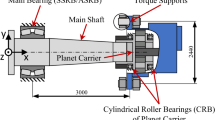Abstract
Since Spherical Roller Bearings (SRBs) have high load capacity and are self-aligning, they are seeing increasing use in the rotating machinery. Typical applications are paper machines, steel rolling, marine equipment, geared transmissions and modern high power wind turbines. Therefore, it is becoming increasingly important to study the dynamic behavior of SRBs and know the excitations caused by internal imperfections. Extensive research has been conducted to study the dynamics of ball bearings, while studies related to spherical roller bearings are short-shrifted. In this paper a three degree of freedom dynamic model of spherical roller bearing that takes into account the inner and outer race surface defects is introduced. In the model, bearing forces and deflections are calculated as a function of contact deformation and bearing geometry parameters according to nonlinear Hertzian contact theory; taking radial clearance into account. Two defect cases are simulated: an elliptical surface concavity on the inner race, and an elliptical surface concavity on the outer race. In case of elliptical surface concavity, it is assumed that the contact between the roller and inner and outer races is continuous as each bearing roller passes over the defect, and contact stiffness in the defect area varies as a function of the defect’s contact geometry. The equations of motion were solved numerically. Simulation results demonstrate that the SRB model is sufficiently accurate for typical rotor bearing systems. Numerical results also show that each local defect excites vibration at a frequencies corresponding to the bearing defect frequencies, and thus, makes it possible to identify the location of the defect (i.e. inner or outer race) from the simulated frequency spectrum. Numerical simulation is carried out successfully for a full rotor-bearing system to demonstrate the application of developed SRB model in a real world analysis. Finally, simulation results are verified and compared to measured data obtained from an equivalent rotor bearing system with a predefined local defect. Comparison shows a good agreement between the simulated and measured results.
Access this chapter
Tax calculation will be finalised at checkout
Purchases are for personal use only
Similar content being viewed by others
References
Tandon N, Choudhury A (1997) An analytical model for the prediction of the vibration response of rolling element bearings due to a localized defect. J Sound Vib 205:275–292. doi:10.1006/jsvi.1997.1031
Sunnersjö CS (1985) Rolling bearing vibrations—the effects of geometrical imperfections and wear. J Sound Vib 98:455–474. doi:10.1016/0022-460x(85)90256-1
McFadden PD, Smith JD (1984) Model for the vibration produced by a single point defect in a rolling element bearing. J Sound Vib 96:69–82. doi:10.1016/0022-460x(84)90595-9
McFadden PD, Smith JD (1985) The vibration produced by multiple point defects in a rolling element bearing. J Sound Vib 98:263–273. doi:10.1016/0022-460x(85)90390-6
Tadina M, Boltezar M (2011) Improved model of a ball bearing for the simulation of vibration signals due to faults during run-up. J Sound Vib 330:4287–4301. doi:10.1016/j.jsv.2011.03.031
Nakhaeinejad M, Bryant MD (2011) Dynamic modeling of rolling element bearings with surface contact defects using bond graphs. J Tribol 133:01110200–01110212. doi:10.1115/1.4003088
Cao M, Xiao J (2008) A comprehensive dynamic model of double-row spherical roller bearing—model development and case studies on surface defects, preloads, and radial clearance. Mech Syst Signal Process 22:467–489. doi:10.1016/j.ymssp.2007.07.007
Ghalamchi B, Sopanen J, Mikkola A (2013) Simple and versatile dynamic model of spherical roller bearing. Int J Rotating Mach 2013:13. doi:10.1155/2013/567542
Author information
Authors and Affiliations
Corresponding author
Editor information
Editors and Affiliations
Rights and permissions
Copyright information
© 2015 Springer International Publishing Switzerland
About this paper
Cite this paper
Ghalamchi, B., Sopanen, J., Mikkola, A. (2015). Spherical Roller Bearing Simulation Model with Localized Defects. In: Pennacchi, P. (eds) Proceedings of the 9th IFToMM International Conference on Rotor Dynamics. Mechanisms and Machine Science, vol 21. Springer, Cham. https://doi.org/10.1007/978-3-319-06590-8_157
Download citation
DOI: https://doi.org/10.1007/978-3-319-06590-8_157
Published:
Publisher Name: Springer, Cham
Print ISBN: 978-3-319-06589-2
Online ISBN: 978-3-319-06590-8
eBook Packages: EngineeringEngineering (R0)




